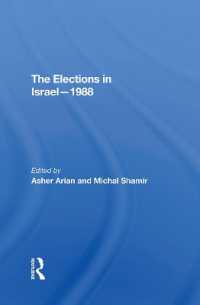Full Description
Assessing Young Children's Development and Learning helps early childhood educators understand both the need for assessment as well as the process of assessment for infants, toddlers, and children up to age eight. Through engaging vignettes, case studies, and exercises, this comprehensive text supports students in confidently applying assessment skills across wide-ranging early childhood educational settings.
Contents
Preface
Acknowledgments
About the Author
Chapter 1: Introduction to Developmentally Appropriate Assessment Practices
What is Assessment in Early Childhood Education?
Purposes of Assessment in Early Childhood Education
Essentials of Developmentally Appropriate Assessment
Legal Rights in Assessment of Young Children
Federal and State Assessment Requirements in Early Childhood
Ethical Practices in the Assessment of Young Children
Summary
Key Terms
Chapter Learning Objectives Assessments
Chapter 2: Observation and Documentation: The Foundation of Assessment of Young Children
Observation + Documentation = Assessment
Developing Close Observation Skills
Errors in Observation
Documenting Individual Children vs. Groups
Evaluating Learning Environments
Observation, Documentation, and the Instructional Cycle
Summary
Key Terms
Chapter Learning Objectives Assessments
Chapter 3: Observation-Based Descriptive Assessment Methods
Observation-Based Assessment Methods that Describe
The Significance of Descriptive Assessment Methods for Planning Instruction and the Learning Environment
Summary
Key Terms
Chapter Learning Objectives Assessments
Chapter 4: Observation-Based Assessment Methods That Count or Rate
Observation-Based Assessment Methods That Count
Observation-Based Rating Assessment Methods
The Significance of Assessment Methods that Count or Rate for Planning Instruction and the Learning Environment
Summary
Key Terms
Chapter Learning Objectives Assessments
Chapter 5: Performance-Based Assessment Methods
Performance-Based Assessment
Assessing Performance-Based Tasks: Rubrics
Summary
Key Terms
Chapter Learning Objectives Assessments
Chapter 6: Informal Paper / Pencil Assessments for the Primary Grades
Feedback and Informal Paper / Pencil Assessment Methods
Worksheets as Assessment Tools
Quizzes and Tests
Strengths and Limitations of Informal Paper / Pencil Assessment Methods
Student Self-Assessment
Summary
Key Terms
Chapter Learning Objectives Assessments
Chapter 7: Formal Standardized Assessments
Brief History of Standardized Tests in the U.S.
Types of Standardized Assessments
Validity and Reliability of Standardized Assessments
Interpreting and Explaining Standardized Assessment Results
Communicating Standardized Assessment Results
Strengths and Limitations of Standardized Assessments
Summary
Key Terms
Chapter Learning Objectives Assessments
Chapter 8: Using Portfolio Data to Plan Instruction
Types of Portfolios
Implicit Bias in Artifact Collection
Involving Children in the Portfolio Process
Using Portfolio Documents to Plan Instruction and Set Goals
Electronic Portfolio Systems
Benefits and Challenges of Portfolios
Summary
Key Terms
Chapter Learning Objectives Assessments
Chapter 9: Using Assessment Data to Support Development, Learning, and Program Improvement
Choosing the Correct Assessment Method
Documentation in Early Childhood Education Models
Data-Based Decision Making
Using Data to Improve Programs and the Environmental Setting
Summary
Key Terms
Chapter Learning Objectives Assessments
Chapter 10: Using Assessments in Tiered Systems of Support
The Response to Intervention (RTI) Approach
The RTI Approach to Challenging Behaviors in Early Childhood
Professional Learning Communities (PLCs) and Response to Intervention (RTI) Leadership Teams
RTI and Multi-Tiered Systems of Support (MTSS)
Summary
Key Terms
Chapter Learning Objectives Assessments
Chapter 11: Assessing Children with Developmental Delays or Disabilities
Accommodations and Modifications in Assessments
Referral Process
IFSP / IEP Process: General Education Teacher's Role
Equity in Accessing Special Services
The Educational Team as Assessment Partners
Monitoring the Progress Towards the IFSP Outcomes or IEP Goals
Summary
Key Terms
Chapter Learning Objectives Assessments
Chapter 12: Assessing Linguistically Diverse Children
Linguistic Diversity and Assessment
Stages of Second Language Acquisition
Best Practices in Assessing Children who are Multilingual Learners (MLLs)
Identifying Children who are Multilingual Learners for Special Services
Collaborating with Professional Colleagues and Assessment Partners
Summary
Key Terms
Chapter Learning Objectives Assessments
Chapter 13: Families as Assessment Partners
Family Partnerships in Assessment
Communication Methods for Assessment Information
Informal Communication Methods
Formal Communication Methods
Cross-Cultural Communication Considerations
Families as a Source of Assessment Information
Summary
Key Terms
Chapter Learning Objectives Assessments
Appendix A: Developmental Milestones
Appendix B
References





